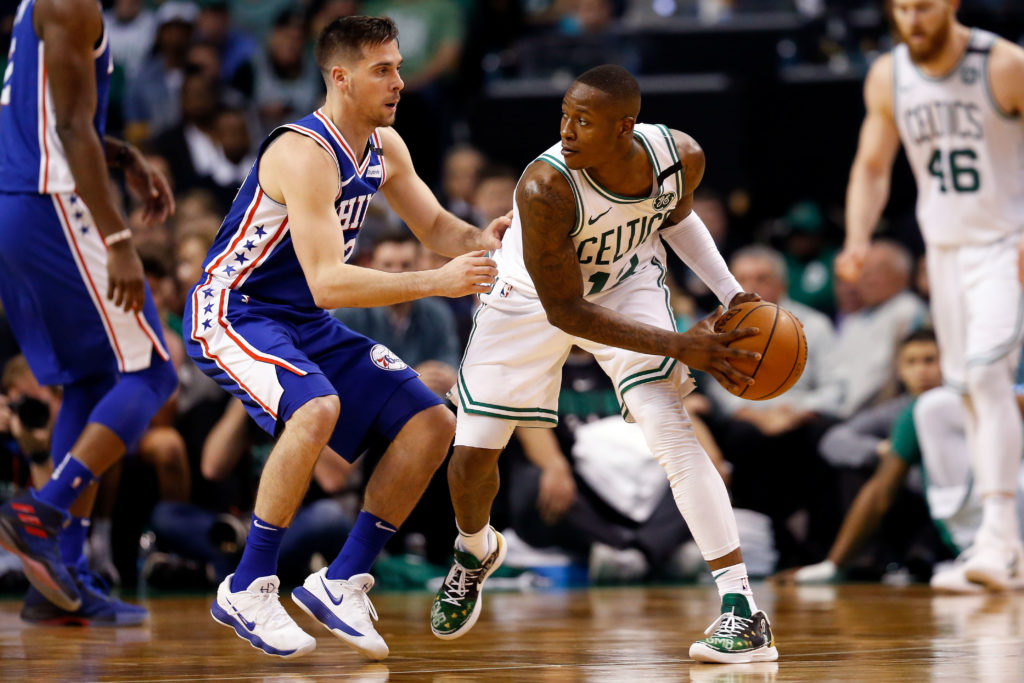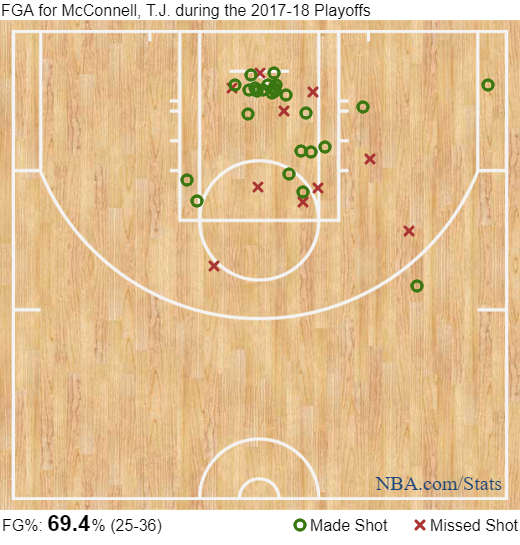Ad Disclosure
Sixers Season Review: T.J. McConnell

This is part seven of a season-ending series looking back at each player’s 2017-2018 campaign.
Part one – Jerryd Bayless / Part two – Timothe Luwawu-Cabarrot / Part three – Justin Anderson / Part four – Richaun Holmes / Part five – Amir Johnson / Part six – Robert Covington
It’s hard not to pull for T.J. McConnell.
Here’s a guy who comes out of Arizona undrafted, lands in summer league with the Sixers and fights his way onto the roster of a rebuilding team. He hustles and dives for loose balls and scrapes and claws his way to cult-hero status while detractors continually describe him as not being good enough for the NBA. Inevitably, they say, Ben Simmons and Markelle Fultz and talented reinforcements will ultimately leave the overachieving 6’2″ point guard without a roster spot.
But here we are, going into the 2018-19 season with the Sixers picking up a contract option that McConnell claims he didn’t even know about.
It’s a great American sports story, but it’s one we need to detach ourselves from if we’re looking objectively at the future of this team. How much of T.J.’s regular (and postseason) body of work can be attributed to the fact that Fultz struggled and barely played? Was the February triple-double legit or a fluke? Is 15 minutes and 7/3/3 more of what we should expect from McConnell on a post-Process team? Or is he a bona fide contributor on a championship-caliber squad?
All of that remains a mystery until the Sixers figure out what they have in Fultz. Putting the #1 overall draft pick in the starting lineup as an off-ball counterpart to Ben Simmons leaves T.J. with the keys to the second team offense. Dropping Fultz to point guard on that second unit either boots McConnell to the bench or forces the pair to play together as ball-sharing guards, which McConnell did with Simmons many times this season, most famously and recently in games four and five of the ill-fated Boston series.
McConnell’s minutes dropped into the teens when Fultz returned to the lineup in late March. He played sparingly in the Miami series, backing up Simmons with just eight minutes per game. He played 12 MPG in the first three Boston games before capping out at 39 and 38 in games four and five.
For season totals, T.J. only started once this year, so his minutes dropped by about 4 per game, but his shooting was better on a career-low 5.5 attempts per game and his turnovers were down:
He did nice work off the bench, playing with the second unit but getting a ton of time with the starters in a staggered role. McConnell’s defensive rating improved about 3 points, from 108 to 105, while his offensive rating improved from 107 to 109.
It was pretty clear what he brought to the Boston series: a defensive solution on the perimeter and a change of pace on the offensive side of the floor, with an up-tempo style congruent with the Sixers’ system but a mode of operation that differs drastically from Ben Simmons.
I wrote a few times this year about his ability to create looks not necessarily by blowing by opponents on the dribble, but by drawing gravity with that baseline “mash” and turning opponent heads. T.J. isn’t always looking to shoot when he does this; oftentimes it’s done with a pass-first mentality:
And on occasions where he isn’t closed down, you’ll see him slip that layup in there, which he got better at timing as the season went on:
If they give you the lane, take it, right?
Sometimes T.J. would overthink these sequences and it would get him into trouble when he’d see a rim protector coming to block his shot. What he would sometimes do is kick back out to the perimeter while out of control and turn the ball over:
You saw that more in the first half of the year, and T.J. did have some rough turnover games. He averaged 2.1 in November and January but did a nice job to get that average down to 1.1 and 1.0 in February and March, respectively. An assist to turnover ratio of 2.71 was better than Simmons’ 2.38.
Shooting-wise, most of his stuff was similar to last season, where he’d get some layups or hit that little pull-up jumper from 5-7 feet or just inside the elbow to his stronger right side.
This is his postseason chart:
That matches his regular season habits, where he was solid hitting the right slot in and around the elbow. He shot well-above the league average in the yellow area but below the average right at the foul line or just inside the stripe:
T.J. shot the three at a career-high 43.5% this season, but only took 62 attempts, which was 10th on the team, sandwiched between Ersan Ilyasova’s 83 tries and Amir Johnson’s 32 prayers. Common knowledge would say he should shoot the ball more, but if you watched him this year (or just those clips above), you know he plays an inside-out game where he penetrates and dishes. He’s a facilitator just like Simmons, and even though he’s a better shooter he’s not out there to throw up 10 shots a game. That’s just not the way he plays and it never has been. There were only five times this season where he put up more than 10 FGA in a game.
McConnell obviously isn’t going to wow anyone with his athleticism or hit a turnaround fadeaway in your grill or go isolation in the 4th quarter of a two-point playoff game. He’s a blue collar grinder who will dive into the crowd for a loose ball and put his body on the line in a “Philly tough” way that the typical fan loves and appreciates. That said, I don’t know what his NBA ceiling is. I don’t know if he’s more than a backup point guard or change-of-pace situational player (Celtics series). Whenever he looked like he didn’t belong, he’d show up with 13, 3, and 7 in 27 minutes off the bench. He had the trust of Brett Brown and the coaching staff.
But it really all comes down to the status of Fultz, and McConnell was asked straight up during his exit interview if he feels like there’s a spot for him on this team should Markelle assume a major role next season:
“Unfortunately, that’s not up to me. I’m gonna be here working my butt off every day. Like I said, Markelle is a special player. That’s not a lie. And when he plays at the level they drafted him to play at, if there’s a spot for me, great. If not, I’m not really sure what I can do about that. Unfortunately that’s out of my hands, but I’d love to be here.”
That was sort of the theme of T.J.’s exit interview – “it’s not up to me”
McConnell is set to earn $1.6 million this year before becoming an unrestricted free agent. His cap hit is less than 2% of the Sixers’ total number, so he’s not breaking the bank on his minimum deal. I get the sense that he doesn’t really want to play anywhere else, though that might end up happening if minutes dry up in Philly.
It’s hard to say. You could really put a fat asterisk on McConnell’s future because he’s one of several players whose status can’t be determined until the dominoes in front of him fall. If he continues to shoot the ball well and perform at a high level while keeping up his positive relationship with fans and the front office, then who knows where his career will go.

Kevin has been writing about Philadelphia sports since 2009. He spent seven years in the CBS 3 sports department and started with the Union during the team's 2010 inaugural season. He went to the academic powerhouses of Boyertown High School and West Virginia University. email - k.kinkead@sportradar.com

